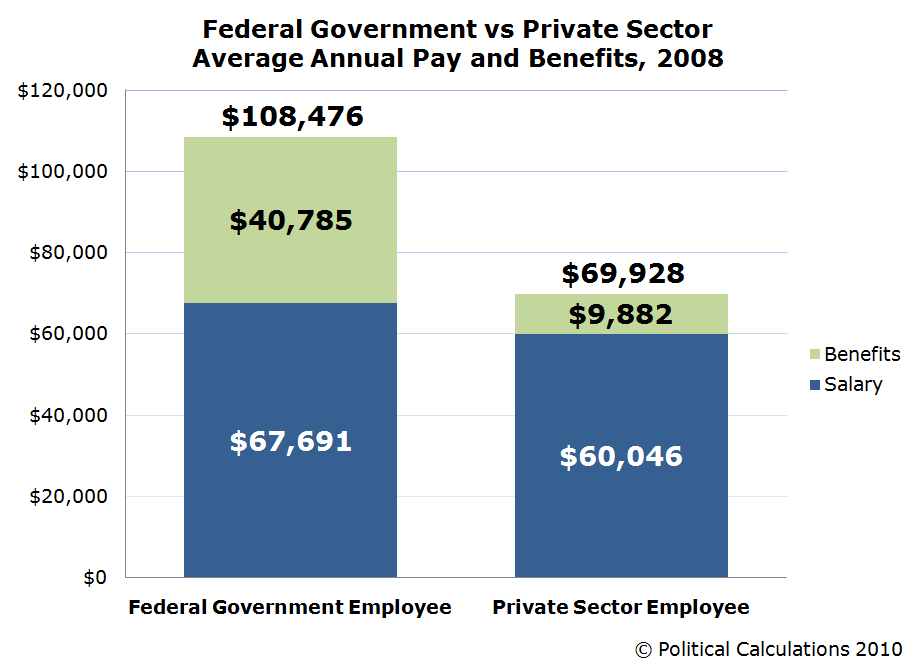Not long ago, we looked at the situation where politicians and bureaucrats use their authority to regulate economic activity to impose costs on regular Americans. In doing that, we noted the role of the “corporate cronies”, who use push for government regulation as a means to put their market competitors at a disadvantage so they can juice their profits, with a portion going into the pockets of their “public servant” benefactors, which they use to advance their own political and personal interests.

We concluded that was “how ‘public servants’ get rich.
Today, we stand corrected, because it turns out that is just one way that public servants can get rich. In truth, most bureaucrats can effectively become millionaires through their extremely generous and taxpayer-guaranteed public employee pension schemes, which accounts for the largest portion of the outsized compensation of public employees compared to their peers in the private sector.
The reason we stand corrected is because of the math that Forbes‘ Rich Karlgaard did to find out what the effective net present value of the retirement nest egg of a simple California state police officer would have to be to provide them with an annual income of $80,000 for the rest of their lives after they retire at Age 55 in The Millionaire Cop Next Door:
It’s said that government workers now make, on average, 30% more than private-sector workers. Put that fantasy aside. It far underestimates the real figures. By my calculations government workers make more than twice as much. They are America’s fastest-growing group of millionaires.
Doubt it? Then ask yourself: What is the net present value of an $80,000 annual pension payout with additional full health benefits? Working backward the total NPV would depend on expected returns of a basket of safe investments–blue-chip stocks, dividends and U.S. Treasury bonds.
Investment pros such as my friend Barry Glassman of Glassman Wealth Services say 4% is a good, safe return today. But that’s a pitiful yield, isn’t it? It’s sure to disappoint the millions of baby boomers who will soon enter retirement with nothing more than their desiccated 401(k)s–down 30% on average from 30 months ago–and a bit of Social Security.
Based on this small but unfortunately realistic 4% return, an $80,000 annual pension payout implies a rather large pot of money behind it–$2 million, to be precise. That’s a lot. One might guess that a $2 million stash would be in the 95th percentile for the 77 million baby boomers who will soon face retirement.
That $2 million also happens to be the implied booty of your average California policeman who retires at age 55.
Really, the only fault we can find with the analysis is that it suggests that cops in California wait until they reach Age 55 to retire with that kind of taxpayer-funded pension benefit. In reality, the average retirement age for police officers in California is somewhere between Age 53 and 55, depending upon whether they work at the state or local level:
The problem with providing such extremely generous pension benefits to public employees is that nobody can afford to pay them, which means that the demand of public servants to receive such generous pension payouts is creating a looming pension disaster:
For years, the state’s coastal cities and inland municipalities have promised — and delivered — larger and larger retirement benefits to public sector workers. Now, California state and local governments face an estimated $655 billion in unfunded pension and health care liabilities.
A new database available at www.transparentcalifornia.com contains salary and pension data for most of California’s government employees. It paints a startling picture of state profligacy. In 2012, over 99,000 California county employees received six-figure salary compensation packages, representing over 50 percent of the estimated full-time workforce, while over 12,000 county workers made in excess of $200,000.
The problem is acute in the Bay Area, where public employee compensation has reached unsustainable highs. Pensions in Alameda County provide 538 retirees with payouts of over $100,000 a year — 25 of which enjoy packages exceeding $200,000 in annual income. Alameda’s retired public defender clears over twice that sum — $527,255 a year. One retired Palo Alto official clears $281,108; a Mountain View retiree, $262,365. From Sunnyvale to Berkeley to San Leandro and beyond, the list goes on and on.
The fiscal irresponsibility doesn’t stop with pensions. The highest-paid public employees enjoy salaries that most taxpayers could only dream of. Hayward’s Deputy Fire Chief pulled down $328,000 in total compensation. A Milpitas fire chief took home $494,000. And in Santa Clara, the acting police chief made out like a bandit with a grand yearly total of $639,000.
Who will protect the interests of the public from the public servants?